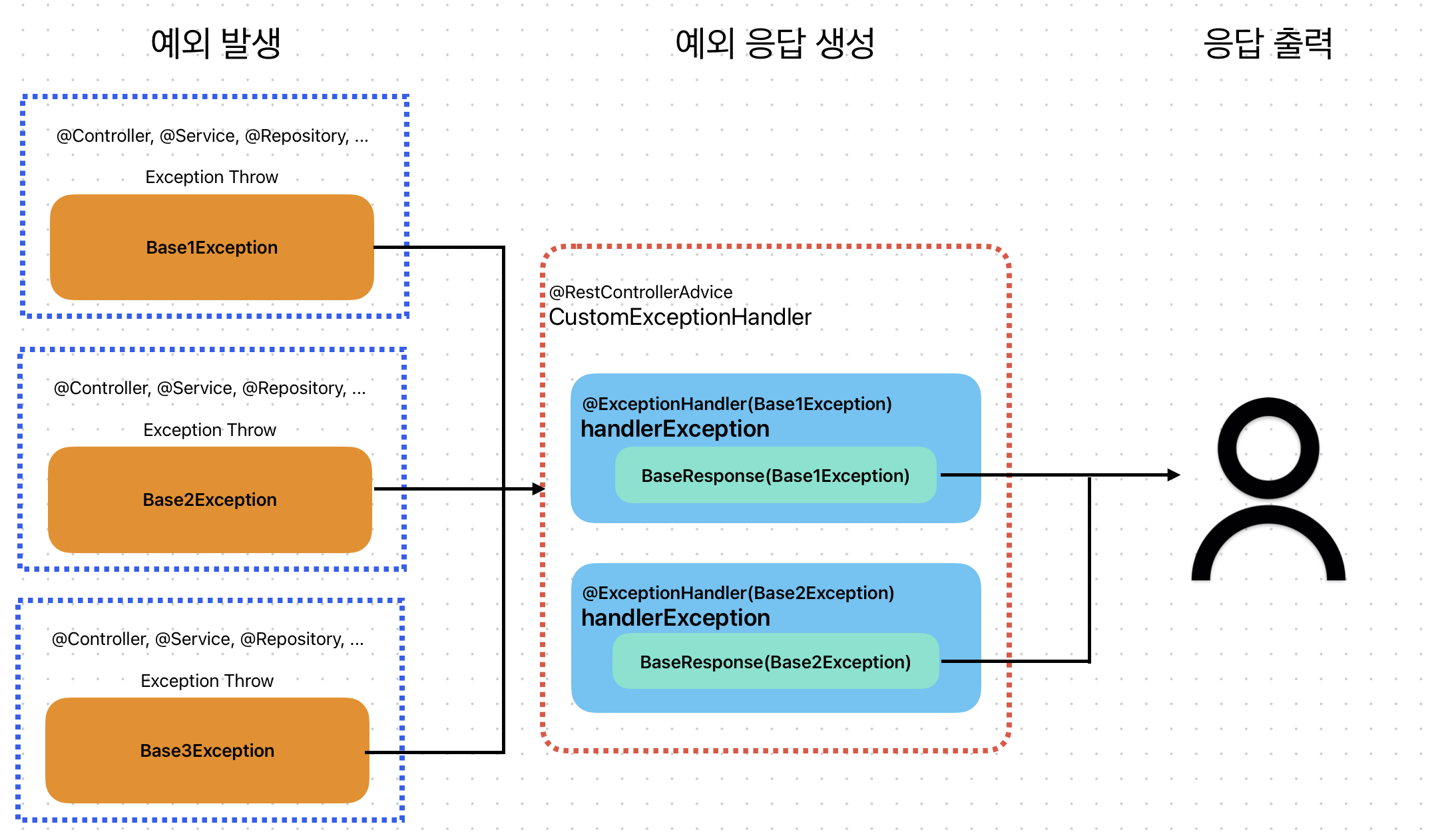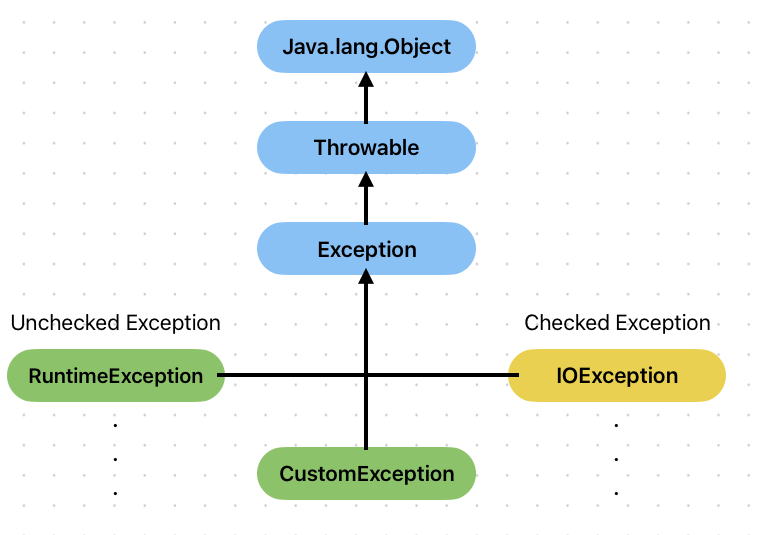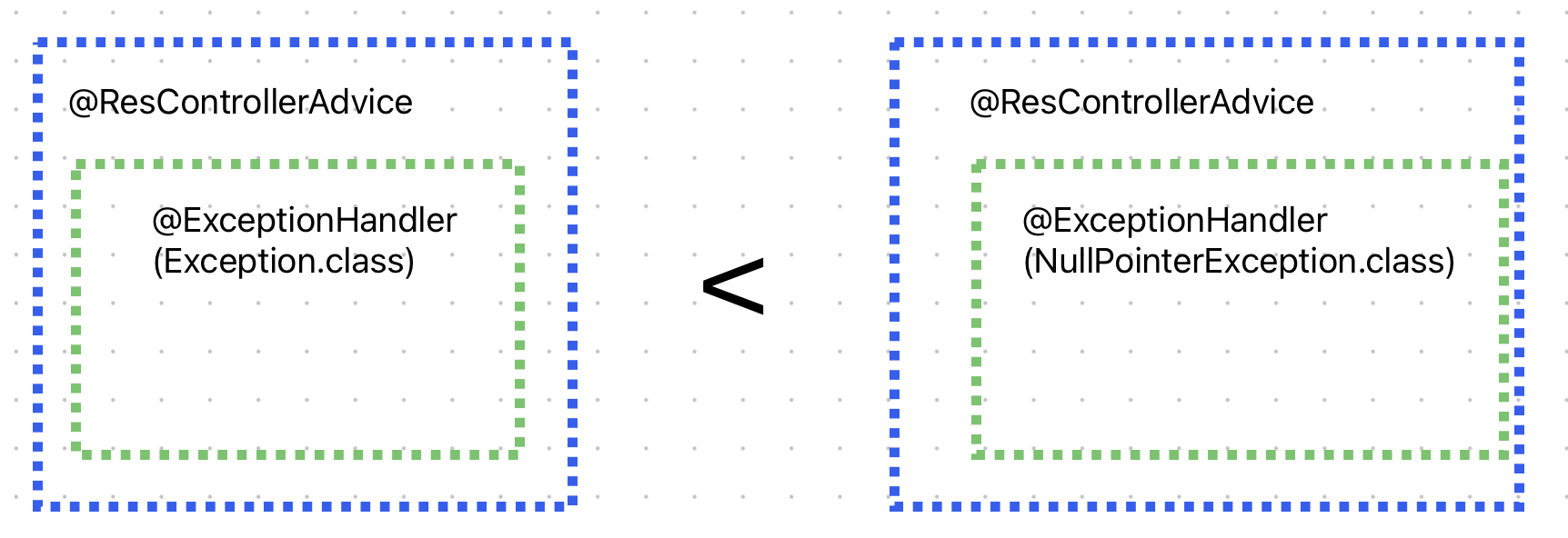- Published on
예외 처리 중앙화와 응답 규격화 (방법)
- Authors

- Name
- Chan Sol OH
대표 이미지

목차
개요
여기어때나 쿠팡 프로젝트를 하면서 예외처리를 위해 수 많은 try-catch-throw 구문을 작성하면서 이를 중앙화할 수 없을지 고민했다. 또한 클라이언트는 api 마다 다른 규격의 응답을 받게되면서 이를 파싱하는데 사용되는 비용을 줄이고자 응답을 규격화하는 방법을 작성했다.

위 그림을 따르면 예외 클래스는 Checked Exception과 Unchecked Exception로 구분할 수 있다. Checked Exception은 반드시 예외처리가 필요하고 확인 시점은 컴파일 단계다. 하지만, Unchecked exception은 명시적 처리를 강제하지 않고 런타임에서 예외를 체크한다.
예외 처리 방식
웹 애플리케이션은 외부의 어떤 요청에 담긴 데이터를 처리하고 적절하게 응답해야한다. 하지만 예외가 발생한다면 애플리케이션이 어림짐작으로 예외를 처리해서 정상 상태의 응답을 하는 것 보다는 클라이언트에게 어떤 예외가 발생했는지 전달해야한다. 이를 위해 각 레이어(Repository, Service,...)에서 발생한 예외를 엔드포인트 레벨인 Controller에게 전달해야한다.
Spring에서 예외를 처리하는 방식은 크게 두가지가 있다.
- @(Rest)ControllerAdvice와 @ExceptionHandler를 통해 모든 컨트롤러의 예외를 처리 : @RestControllerAdvice를 사용하면 클라이언트에게 결과값을 JSON 형태로 반환할 수 있다.
- @ExceptionHandler를 통해 특정 컨트롤러의 예외를 처리
CustomExceptionHandler 만들기
// 글로벌 예외처리
@RestControllerAdvice // Controller나 RestController가 적용된 빈에서 발생하는 예외를 잡아 처리
@Slf4j
public class CustomExceptionHandler {
@ExceptionHandler(value = {RuntimeException.class, NullPointerException.class}) //RuntimeException나 NullPointerException가 발생하는 예외가 발생하면 처리하는 메서드
public ResponseEntity<Map<String, String>> handlerException(RuntimeException e, HttpServletRequest request){
log.error("Advice 내 handleException 호출, {} {}", request.getRequestURL(), e.getMessage());
// 클라이언트에게 보낼 응답 메세지 만들기
HttpHeaders httpHeaders = new HttpHeaders();
HttpStatus httpStatus = HttpStatus.BAD_REQUEST;
Map<String, String> map = new HashMap<>();
map.put("error type", httpStatus.getReasonPhrase());
map.put("code","400");
map.put("message", e.getMessage());
return new ResponseEntity<>(map, httpHeaders,httpStatus);
}
}
@RestControllerAdvice는 Controller나 RestController가 적용된 빈에서 발생하는 예외를 잡아 처리함을 의미@ExceptionHandler는 value 안에 배열로 정의된 예외들이 발생하면 해당 메서드를 실행시키도록함.- map으로 예외 반환 값을 json에 넘기고, httpHeader와 httpStatus를 모두
ResponseEntity로 묶어서 응답한다. 클라이언트는 Map 객체의 값을 아래와 같이 json으로 받게된다.map_response.json{ "code": "400", "error type": "Bad Request", "message": "getRuntimeException 호출" }
Exception의 우선 순위

위 그림을 보면 하위의 클래스인 NullPointerException.class의 예외처리 핸들러가 더 우선순위를 가지게된다. 또한 동일한 예외를 처리하더라고 ExceptionHandler의 위치에 따라 우선순위가 달라질 수 있다. 항상 컨트롤러 안에 작성된 ExceptionHandler가 글로벌로 작성된 ExceptionHandler에 우선한다.
커스텀 예외
커스텀 예외를 사용하면 예외의 이름만으로 어떤 예외 상황인지 알 수 있다. 표준 예외를 상속받은 커스텀 예외들은 개발자가 코드로 관리하기 때문에 책임 소재를 애플리케이션 내부로 가져올 수 있고, 동일한 예외 상황이 발생할 경우 예외처리를 중앙화하여 상황에 맞는 예외 코드를 적용할 수 있다.
@Getter
public enum CustomResponseStatus {
SUCCESS(true, HttpStatus.OK, "요청에 성공하였습니다."),
NO_CONTENT(true, HttpStatus.NO_CONTENT, "요청에 성공했지만, 컨텐츠는 없습니다."),
POST_USERS_EMPTY_EMAIL(false, HttpStatus.BAD_REQUEST, "이메일을 입력해주세요."),
// ...
DELETE_FAIL_PRODUCT(false, HttpStatus.INTERNAL_SERVER_ERROR, "상품 삭제 실패"),
DELETE_FAIL_IMAGE(false, HttpStatus.INTERNAL_SERVER_ERROR, "이미지 삭제 실패");
private final boolean isSuccess;
private final HttpStatus code;
private final String message;
private CustomResponseStatus(boolean isSuccess, HttpStatus code, String message) {
this.isSuccess = isSuccess;
this.code = code;
this.message = message;
}
}
Http Status를 커스텀 예외 클래스에 포함시키면 위 ExceptionHandler처럼 핸들러 안에서 선언해서 사용하는 것이 아닌 예외클래스만 전달받으면 그 안에 내용이 포함돼 있는 구조로 설계할 수 있다. 메세지 만드는 것도 추상화를 할 수 있는 것이다.
public class CustomException extends RuntimeException{
private CustomResponseStatus status;
public BaseException(CustomResponseStatus status) {
super(status.getMessage());
this.printStackTrace();
this.status = status;
}
public CustomResponseStatus getStatus() {
return this.status;
}
public void setStatus(final CustomResponseStatus status) {
this.status = status;
}
}
종합하면 비즈니스 로직이나 컨트롤러에서 발생한 예외를 CustomException으로 발생시키고, 그 예외 코드나 메세지는 CustomResponseStatus로 중앙화하여 관리할 수 있다. 이로써 프로젝트를 개발하면서 발생하는 예외와 메세지는 통일성 있게 관리할 수 있다.
공통 응답
웹 애플리케이션이 예외나 컨텐츠를 클라이언트에게 응답할 때 공통적인 형식을 가지고 응답하게 되면 클라이언트는 응답의 형태를 신경쓰지 않고 오로지 뷰에만 집중할 수 있게된다. 그러기 위해선 요청의 성공과 실패를 알 수 있도록하고 메세지, code, 및 result를 포함해서 출력한다. 정리하면 성공이나 예외에 대한 응답을 규격화된 형태로 감싸서 응답하는 것이다.
@JsonPropertyOrder({"is_success", "code", "message", "result"})
@Getter
public class BaseResponse<T> {
// Http Response의 일관성을 높이자
@JsonProperty("is_success") // json 객체 내의 Key 값 설정
private final Boolean isSuccess;
private final String message;
private final HttpStatus code;
@JsonInclude(JsonInclude.Include.NON_NULL) // json을 만들 때 null인 객체는 제외한다.
private T result;
public BaseResponse(T result) {
// 응답에 성공하고 컨텐츠가 있는 경우, create, update, read 경우
this.isSuccess = BaseResponseStatus.SUCCESS.isSuccess();
this.message = BaseResponseStatus.SUCCESS.getMessage();
this.code = BaseResponseStatus.SUCCESS.getCode();
this.result = result;
}
public BaseResponse(BaseResponseStatus status) {
// 예외 발생한 경우
this.isSuccess = status.isSuccess();
this.message = status.getMessage();
this.code = status.getCode();
}
}
위 BaseResponse를 확인하면 클라이언트는 isSuccess를 확인하고 false 일 경우 message를 화면에 띄운다던가 별도의 예외 처리 로직을 동작시킬 수 있다. 또한 정상적인 응답이라면 result에 객체가 들어가기 때문에 클라이언트는 result만 확인하면된다.
예외 처리 통합
CustomException, CustomResponseStatus, CustomExceptionHandler 그리고 BaseResponse를 종합하면 아래와 같이 예외처리를 중앙화하여 응답할 수 있다.

@RestControllerAdvice // Controller나 RestController가 적용된 빈에서 발생하는 예외를 잡아 처리
@Slf4j
public class CustomExceptionHandler {
// 예외가 발생하면 status를 받아서 공통 형식으로 출력
@ExceptionHandler(value = {BaseException.class})
public BaseResponse baseHandlerException(BaseException baseException){
return new BaseResponse(baseException.getStatus());
}
// 특정한 예외 같은 것은 직접 주입할 수 있다.
@ExceptionHandler(value = {MethodArgumentNotValidException.class})
public BaseResponse methodArgumentNotValidHandlerException(MethodArgumentNotValidException m){
return new BaseResponse(BaseResponseStatus.POST_INVAILD_ARGUMENT);
}
}
위 CustomExceptionHandler는 예외처리를 중앙에서 처리하고 공통 형태의 BaseResponse로 넘겨주는 역할을 한다. 또한 비즈니스 로직 같이 사용자가 예외를 직접 발생시키지 못하는 경우 methodArgumentNotValidHandlerException처럼 ExceptionHandler를 설정하여 제어할 수 없는 예외를 처리하고 규격화된 응답을 클라이언트에게 제공할 수 있다.
{
"isSuccess": false,
"code": "BAD_REQUEST",
"message": "올바른 입력 형식이 아닙니다."
}
